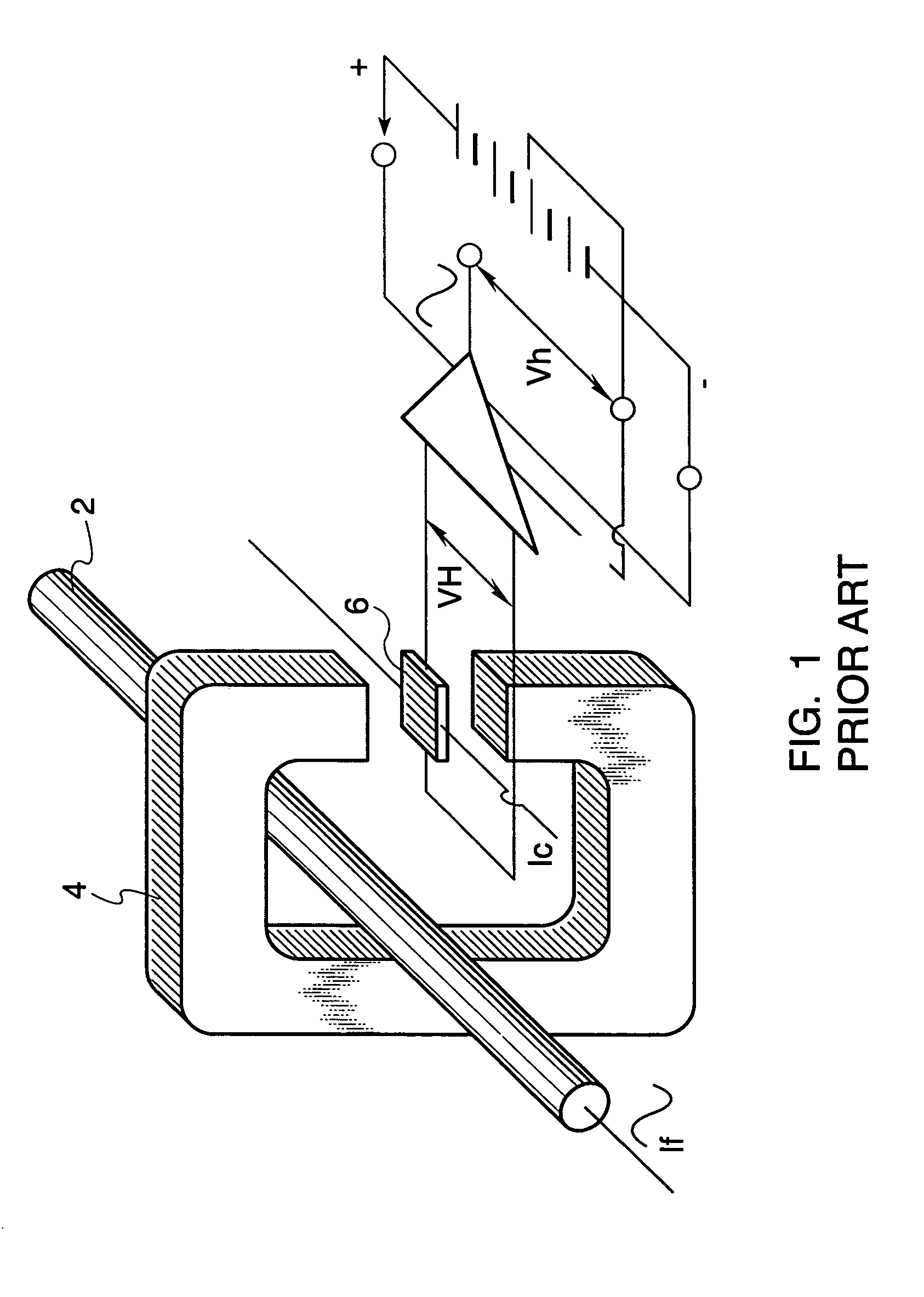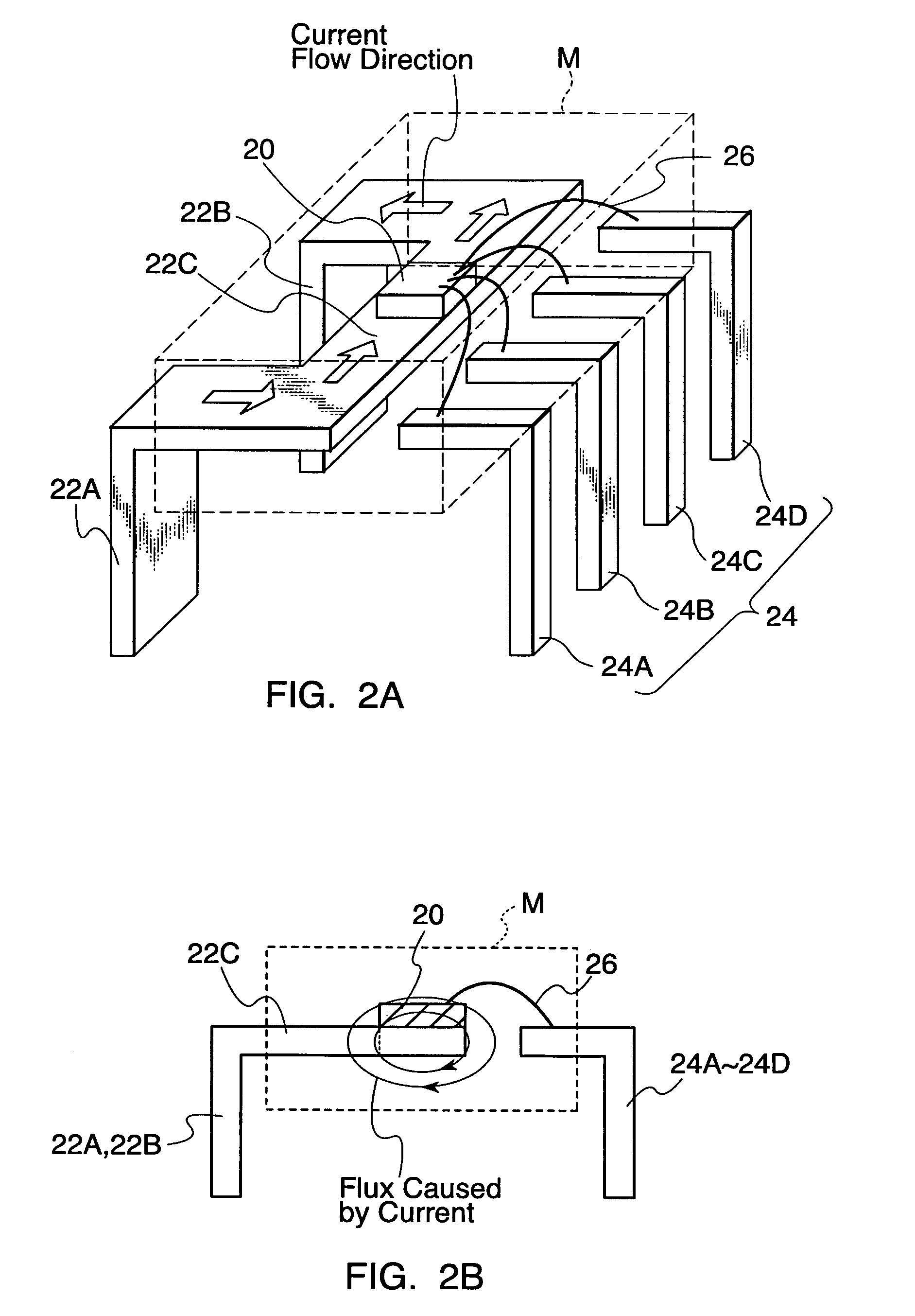Current sensor and current sensor manufacturing method
a current sensor and manufacturing method technology, applied in the field of current sensors, can solve the problems of low cost, inconvenient miniaturization of current sensors, and inability to manufacture sensors in mass quantities, and achieve the effect of reducing the width of current conductors and substantially increasing the detection sensitivity of magnetic field detection elements
- Summary
- Abstract
- Description
- Claims
- Application Information
AI Technical Summary
Benefits of technology
Problems solved by technology
Method used
Image
Examples
embodiment 1
[0073]FIG. 2A is a perspective view showing schematically the entire configuration of a current sensor employing the present invention. FIG. 2B is a view showing schematically the configuration of the current sensor shown in FIG. 2A. In these views, reference numeral 20 denotes a magnetic field sensor chip including a magnetic field detection element like a Hall element and so on, reference numerals 22A to 22C denote current conductors for applying a current to be measured, and reference numerals 24A to 24D denote lead frame terminals. Each of the lead frame terminals 24A to 24D and the current conductor 22A to 22C are formed from a single thin plate-like metal as will be discussed later (FIG. 4A and FIG. 4B). Reference numeral 26 denotes a bonding wire for connecting the lead frame terminals 24A to 24D and the magnetic field sensor chip 20. Further, reference character M denotes a part to be molded in plastics.
[0074]FIGS. 3A, 3B, and 3C are, respectively, a perspective view, a sec...
embodiment example
[0079] The following will discuss an embodiment example corresponding to FIG. 2A.
[0080] A copper plate with a thickness of 0.4 mm was used as a thin plate-like metal (FIG. 4A) to form the current conductor 22A to 22C and the lead frame terminals 24A to 24D as one. As described above, FIG. 4A shows that a plurality of chips are connected. Manufacturing in large quantity was readily performed by using completely the same process used for lead frames of a typical integrated circuit. Then the above lead frames were used to form a current sensor molded in plastics used for an integrated circuit. This is shown in FIG. 4B.
[0081] The width of the center part 22C of the current conductor placing the magnetic field sensor chip 20 thereon was about 2 mm, and the outside of the molded plastics was about 5.5 mm in width, and a maximum current of 25A could be applied continuously. The Hall ASIC shown in FIGS. 3B and 3C was applied on the magnetic field sensor chip 20. The Hall ASIC was fixed on...
embodiment 2
[0083]FIGS. 5A and 5B are schematical perspective views showing the entire configuration of a current sensor corresponding to another embodiment. In these views, in addition to the configuration of FIG. 2, a soft thin plate-like magnetic material 50 is bonded beneath a current conductor 22C (that is, bonded on the opposite side from a magnetic field sensor chip 20).
[0084]FIGS. 6A, 6B, and 6C are explanatory drawings showing the function of the soft, thin plate-like magnetic material 50 shown in FIGS. 5A and 5B.
[0085] As shown in FIGS. 5A, 5B, 6A, 6B, and 6C, the soft, thin plate-like magnetic material 50 with high magnetic permeability, high saturation flux density, and low coercive force is bonded on the backside of an island part 22C of the current conductor, so that the soft, thin plate-like magnetic material 50 absorbs an external flux entering from the outside of the current sensor, and that it passes through the plate 50. Thus, it is possible to reduce influence of the exter...
PUM
 Login to View More
Login to View More Abstract
Description
Claims
Application Information
 Login to View More
Login to View More - R&D
- Intellectual Property
- Life Sciences
- Materials
- Tech Scout
- Unparalleled Data Quality
- Higher Quality Content
- 60% Fewer Hallucinations
Browse by: Latest US Patents, China's latest patents, Technical Efficacy Thesaurus, Application Domain, Technology Topic, Popular Technical Reports.
© 2025 PatSnap. All rights reserved.Legal|Privacy policy|Modern Slavery Act Transparency Statement|Sitemap|About US| Contact US: help@patsnap.com



